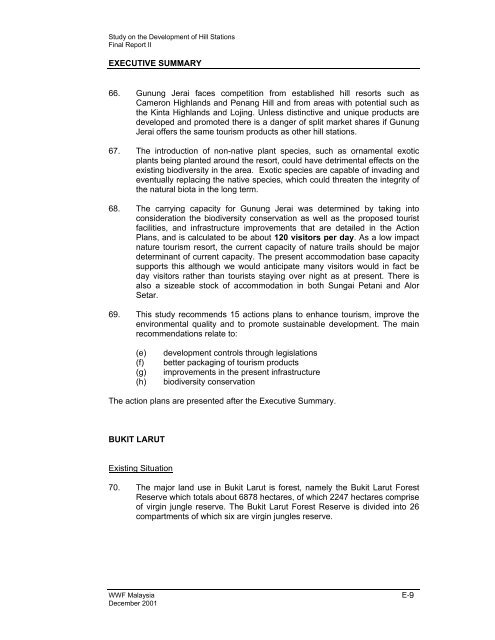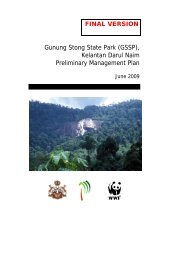WWFM_Hill Stations Study Vol2_2001.pdf - Sdn Bhd - WWF Malaysia
WWFM_Hill Stations Study Vol2_2001.pdf - Sdn Bhd - WWF Malaysia
WWFM_Hill Stations Study Vol2_2001.pdf - Sdn Bhd - WWF Malaysia
Create successful ePaper yourself
Turn your PDF publications into a flip-book with our unique Google optimized e-Paper software.
<strong>Study</strong> on the Development of <strong>Hill</strong> <strong>Stations</strong><br />
Final Report II<br />
EXECUTIVE SUMMARY<br />
66. Gunung Jerai faces competition from established hill resorts such as<br />
Cameron Highlands and Penang <strong>Hill</strong> and from areas with potential such as<br />
the Kinta Highlands and Lojing. Unless distinctive and unique products are<br />
developed and promoted there is a danger of split market shares if Gunung<br />
Jerai offers the same tourism products as other hill stations.<br />
67. The introduction of non-native plant species, such as ornamental exotic<br />
plants being planted around the resort, could have detrimental effects on the<br />
existing biodiversity in the area. Exotic species are capable of invading and<br />
eventually replacing the native species, which could threaten the integrity of<br />
the natural biota in the long term.<br />
68. The carrying capacity for Gunung Jerai was determined by taking into<br />
consideration the biodiversity conservation as well as the proposed tourist<br />
facilities, and infrastructure improvements that are detailed in the Action<br />
Plans, and is calculated to be about 120 visitors per day. As a low impact<br />
nature tourism resort, the current capacity of nature trails should be major<br />
determinant of current capacity. The present accommodation base capacity<br />
supports this although we would anticipate many visitors would in fact be<br />
day visitors rather than tourists staying over night as at present. There is<br />
also a sizeable stock of accommodation in both Sungai Petani and Alor<br />
Setar.<br />
69. This study recommends 15 actions plans to enhance tourism, improve the<br />
environmental quality and to promote sustainable development. The main<br />
recommendations relate to:<br />
(e)<br />
(f)<br />
(g)<br />
(h)<br />
development controls through legislations<br />
better packaging of tourism products<br />
improvements in the present infrastructure<br />
biodiversity conservation<br />
The action plans are presented after the Executive Summary.<br />
BUKIT LARUT<br />
Existing Situation<br />
70. The major land use in Bukit Larut is forest, namely the Bukit Larut Forest<br />
Reserve which totals about 6878 hectares, of which 2247 hectares comprise<br />
of virgin jungle reserve. The Bukit Larut Forest Reserve is divided into 26<br />
compartments of which six are virgin jungles reserve.<br />
<strong>WWF</strong> <strong>Malaysia</strong> E- 9<br />
December 2001
















